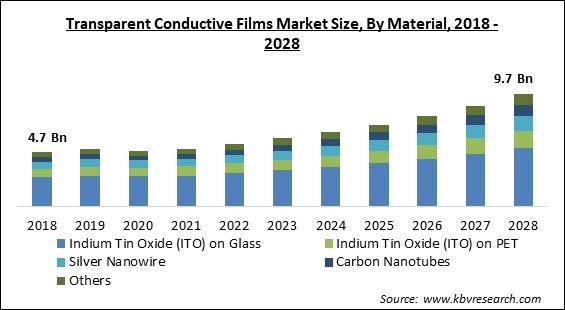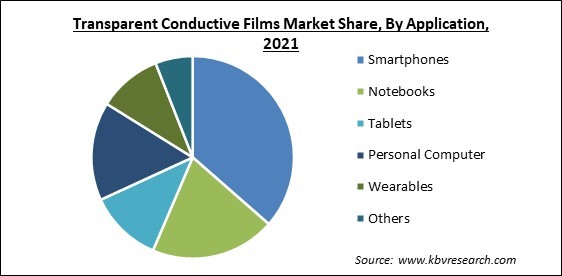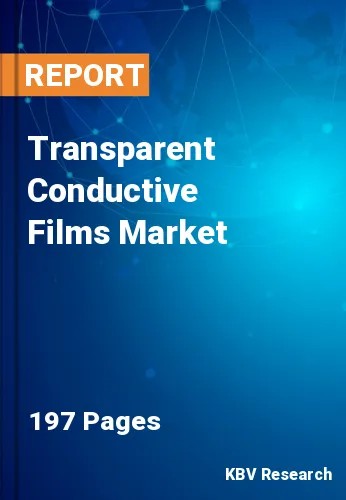The Global Transparent Conductive Films Market size is expected to reach $9.7 billion by 2028, rising at a market growth of 10.2% CAGR during the forecast period.
Transparent conductive films, or TCF, are optically transparent thin films made of electrically conductive material. Transparent conductive films are used as transparent electrodes in touch screens and cover electrodes for solar cells, LCDs, organic light-emitting diodes, and other devices. A thin coating of conductive material is deposited on a translucent polymer-based substrate of around 50–150m thick to create TCFs of less than 100 nm thickness. Some of the most common conductive layers include metal oxides (InO2: Sn, SnO2: F), metal meshes (copper, silver, gold), silver nanofibers, graphene, and conductive polymers (PEDOT: PSS), and carbon nanotubes.
Transparent materials have large bandgaps with higher energy values than visible light. As a result, photons with energies lower than the bandgap value are not absorbed, and visible light flows through. To make optimum use of the entire solar spectrum, some applications, such as solar cells, require a larger range of transparency beyond visible light. These transparent-yet-conductive thin films are now essential components of smartphones' high-resolution liquid crystal screens and touch sensor functionalities. Various manufacturers continue to make advancements in the field of transparent conductive films and ITO. Transparent electrodes for the next generation of solar cells, transparent electrodes and anti-static protection in touch screen displays, and even dew condensation, as well as snow accumulation prevention for transparent heaters, can all benefit from ITO and transparent conductive films. The options are limitless. Customers can incorporate the technology into their products for best-in-class outcomes.
Owing to the increasing need for touch-enabled devices and industrial penetration of portable computing devices, the demand for TCF is increasing across several application industries. OPV and DSSC, as well as OLED lighting, are other prospective markets. TCF consumption per unit is substantially higher in smartphones than in tablets as well as tablet PCs. Therefore, due to the increasing deployment in smartphones, the demand for transparent conductive films is rising all over the world.

The COVID-19 pandemic had a severe impact on the electronics and semiconductor industries. Due to an increase in the number of COVID-19 cases, business and manufacturing units in several nations were closed during the pandemic. Additionally, the partial or total lockdown has affected the worldwide supply chain, making it difficult for manufacturers to reach their clients. The COVID-19 pandemic majorly damaged society and the global economy. The impact of this pandemic is expanding by the day, and it is disrupting the industry. The crisis is causing uncertainty in the stock market, which is leading to a drop in corporate confidence, a major slowdown in supply chains, and an increase in customer concern.
Smartphone usage is increasing as the world becomes more digitalized. Smartphone adoption has increased as a result of the increasing population along with the availability as well as affordability of smartphones across the market. People purchase smartphones in order to streamline their day-to-day tasks. Moreover, with the increasing penetration of smartphones all over the world, consumers are also getting a wide range of choices to buy the best-in-class smartphones. Smartphones can significantly facilitate various tasks. For example, in the modern era, even the most basic smartphone would be comprising an in-built camera, clock, calculator, and various other tools. Smartphones are very handy and can replace various sizeable tools, which requires more space.
Government subsidies for the manufacture of smartphones are gradually rising. Smartphone imports raise the cost of cell phones, creating a barrier to their broad adoption. Many countries are encouraging indigenous smartphone manufacturing by providing incentives. Many high-quality phones with a wide range of functions have been recently introduced to the market. People are drawn toward purchasing these enticing mobile phones, but security is also a huge concern. The displays on these phones cannot be rebuilt in such a way that they look to be brand new if they crack for any reason. Tempered glass is frequently used to offer protection to these phones.
Transparent conductive films are being widely utilized across the manufacturing of smartphones, tablets, PCs, and various other smart devices like smart wearables. However, there are a number of alternatives that can be utilized as a replacement for TCF with more advantages. Carbon nanotubes were created as an ITO replacement that could also help to overcome the drawbacks of transparent conductive films. They benefit from the same advantages as transparent conductive films. CNTs are formable, flexible, and inexpensive to the pattern. They also provide better environmental stability, allowing producers to avoid additional expenditures associated with meeting environmental criteria.

Based on Material, the market is segmented into Indium Tin Oxide (ITO) on Glass, Indium Tin Oxide (ITO) on PET, Silver Nanowire, Carbon Nanotubes, and Others. In 2021, the Indium Tin Oxide (ITO) on PET segment garnered a significant revenue share of the transparent conductive films market. ITO-on-PET is being highly demanded across the market. Many people are considering alternatives due to the uncertainties around the cost of raw indium. The restricted sheet resistance (150-350 ohm/sqr) would likewise fall short of emerging application requirements. ITO-on-PET has some flexibility, but it will break if bent too much or too many times. These factors are augmenting the growth of this segment.
Based on Application, the market is segmented into Smartphones, Notebooks, Tablets, Personal Computer, Wearables, and Others. In 2021, the smartphones segment acquired the highest revenue share of the transparent conductive films market. The rising growth of this segment is attributed to the growing number of smartphone consumers around the world. Moreover, smartphones have become the necessity of the life as it comprises various useful features, such as alarms and calculator. Therefore, this factor is propelling the growth of this segment.
| Report Attribute | Details |
|---|---|
| Market size value in 2021 | USD 4.8 Billion |
| Market size forecast in 2028 | USD 9.7 Billion |
| Base Year | 2021 |
| Historical Period | 2018 to 2020 |
| Forecast Period | 2022 to 2028 |
| Revenue Growth Rate | CAGR of 10.2% from 2022 to 2028 |
| Number of Pages | 197 |
| Number of Tables | 310 |
| Report coverage | Market Trends, Revenue Estimation and Forecast, Segmentation Analysis, Regional and Country Breakdown, Companies Strategic Developments, Company Profiling |
| Segments covered | Material, Application, Region |
| Country scope | US, Canada, Mexico, Germany, UK, France, Russia, Spain, Italy, China, Japan, India, South Korea, Singapore, Malaysia, Brazil, Argentina, UAE, Saudi Arabia, South Africa, Nigeria |
| Growth Drivers |
|
| Restraints |
|
Based on Regions, the market is segmented into North America, Europe, Asia Pacific, and Latin America, Middle East & Africa. In 2021, Asia-Pacific held the largest revenue share of the transparent conductive films market. The constantly expanding automotive sector in in this region is majorly expediting the growth of the regional transparent conductive films market, owing to rising demand for luxury automotive along with increasing expenditure on advanced technology adoption. In addition, the growing use of transparent conductive films across the regional solar power sector would fuel the growth of the regional market in the forecasting years.
Free Valuable Insights: Global Transparent Conductive Films Market size to reach USD 9.7 Billion by 2028
The market research report covers the analysis of key stake holders of the market. Key companies profiled in the report include 3M Company, Fujifilm Holdings Corporation, Dupont Teijin Films, Cambrios Film Solutions Corporation, TDK Corporation, Eastman Kodak Company, Nitto Denko Corporation, Toyobo Co., Ltd., Canatu Oy, and Dontech, Inc.
By Material
By Application
By Geography
The global transparent conductive films market size is expected to reach $9.7 billion by 2028.
An increasing number of government support and subsidiaries are increasing are driving the market in coming years, however, presence of alternatives across the market growth of the market.
3M Company, Fujifilm Holdings Corporation, Dupont Teijin Films, Cambrios Film Solutions Corporation, TDK Corporation, Eastman Kodak Company, Nitto Denko Corporation, Toyobo Co., Ltd., Canatu Oy, and Dontech, Inc.
The Indium Tin Oxide (ITO) on Glass segment acquired maximum revenue share in the Global Transparent Conductive Films Market by Material in 2021, thereby, achieving a market value of $5.0 billion by 2028.
The Personal Computer segment is showcasing a CAGR of 11.2% during (2022 - 2028).
The Asia Pacific is the fastest growing region in the Global Transparent Conductive Films Market by Region in 2021, and would continue to be a dominant market till 2028.
Our team of dedicated experts can provide you with attractive expansion opportunities for your business.

